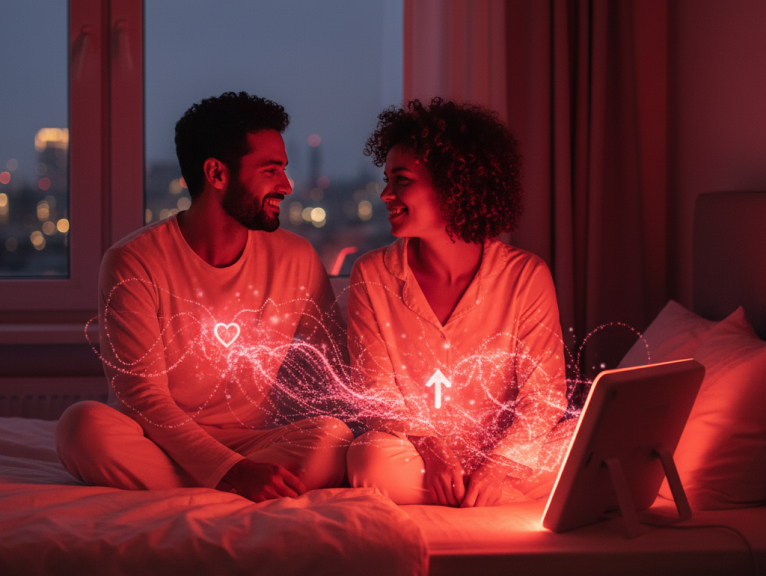
20 Years of Producing the Highest Quality, Most Reliable, and Effective LED mask.
Discover how red light therapy (photobiomodulation) may enhance sexual well-being by supporting hormones, nitric-oxide-driven blood flow, tissue comfort, mood, and sleep—plus safe protocols and realistic expectations.

Red light therapy—also called photobiomodulation (PBM) or low-level light/laser therapy (LLLT)—uses specific red and near-infrared wavelengths to modulate cellular function without heat or tissue damage. Beyond skin rejuvenation and exercise recovery, a growing body of research suggests PBM may influence several pillars of sexual well-being: hormonal balance, genital blood flow and vascular health, arousal and lubrication, mood and sleep, and recovery from inflammation-related discomfort. This article keeps the original theme—“better sex via better biology”—but deepens the scientific rationale, clarifies what is known vs. emerging, and offers practical, safe-use guidance.
PBM’s core target is the mitochondrion. Red/NIR photons are absorbed (notably by cytochrome-c oxidase), improving electron transport and ATP synthesis, and modulating redox signaling. These shifts can dampen excess inflammation, support tissue repair, and tune neuroendocrine pathways—all relevant to libido and performance. For a rigorous overview of the mechanisms and anti-inflammatory signaling cascades, see this NIH/PMC review on photobiomodulation’s immunometabolic effects: Mechanisms and applications of the anti-inflammatory effects of photobiomodulation (NIH/PMC).
What this means for sexual health:
Sexual arousal—clitoral/vaginal engorgement and penile erection—depends on rapid nitric-oxide-mediated vasodilation. PBM can liberate nitric oxide (NO) from heme proteins and stimulate endothelium-dependent signaling, improving microcirculation. A detailed physiological analysis of light-triggered vascular relaxation is available here: Photorelaxation of arteries and nitric oxide biology (NIH/PMC).
Implications you can feel:
Reality check: Robust, sham-controlled human RCTs targeting ED with PBM are still limited; results are promising mechanistically, but protocols (wavelength, fluence, timing) need standardization.
Light exposure can influence circadian and neuroendocrine signaling (melatonin, LH/FSH rhythms), which in turn may modulate sex steroids like testosterone. The PBM link is plausible—by increasing cellular energy and improving testicular/ovarian microcirculation, you can “support the system” that makes hormones. Clinically, libido is multifactorial; subtle improvements in energy, mood, and sleep often boost desire even without large hormone swings.
Practical takeaway:
Women frequently report sexual discomfort from local inflammation, pelvic floor tension, or post-menopausal tissue changes. PBM’s anti-inflammatory and pro-repair signaling (fibroblast activity, collagen metabolism) can support comfort and tissue quality. While gynecologic laser therapies are distinct technologies, PBM’s non-thermal approach is attractive as a gentle, home-friendly option. For skin/tissue evidence on LED phototherapy’s remodeling and anti-inflammatory effects, see this plain-English summary: LED Light Therapy for Skin (WebMD).
How this maps to intimacy: Less irritation and more pliable, better-perfused tissue often means easier arousal, improved lubrication, and less pain—key drivers of sexual satisfaction.
Low mood, anxiety, and poor sleep are among the most potent libido suppressors. Two complementary light-based strategies are relevant:
Why it matters sexually: Better circadian alignment and mood typically translate into higher spontaneous desire, more energy for intimacy, and improved sexual satisfaction.
Supported by mechanistic and adjacent clinical data:
Still emerging or preliminary:
Bottom line: The biological “plumbing” (mitochondria, NO, microcirculation, inflammation, sleep) is plausibly improved by PBM; sexual benefits follow from those upstream systems. Expect adjunctive gains—not a silver bullet.
Device & wavelengths:
Session structure:
Targeting:
Integrations:
Safety:
Q1: Is red light therapy safe for intimate areas?
A1: When used as directed with non-thermal PBM devices, red/NIR light is generally well tolerated. Avoid excessive heat, keep appropriate distance, wear eye protection for bright panels, and do not use over suspected malignancy. If you’re pregnant or on photosensitizing medication, consult a clinician first.
Q2: Will PBM raise testosterone?
A2: Mechanistically plausible (mitochondrial support, microvascular perfusion, circadian-pituitary signaling), but direct, large RCTs with sustained increases are limited. Many users report improved vitality/libido with regular morning routines; consider PBM a supportive, not primary, endocrine therapy.
Q3: Can PBM help female libido?
A3: Libido in women is strongly biopsychosocial. PBM can support comfort (less inflammation), circulation, energy/mood, and sleep—factors that often move the needle on desire and satisfaction—even though direct sex-function RCTs in women are sparse. Start with comfort-focused, external protocols and whole-person strategies.
Q4: How soon will I notice changes?
A4: Flow-related effects can be acute (same-day). Sleep/mood benefits tend to appear within 2–4 weeks; tissue comfort within 3–6 weeks. Reassess after 6–8 weeks of consistent use.
Q5: What about combining with other therapies?
A5: Smart pairing. For men with ED, continue guideline-based care (lifestyle, PDE5 inhibitors if prescribed). For women with discomfort/lubrication issues, pair PBM with pelvic floor care, moisturizers, and clinician guidance. For sleep/mood, combine morning bright light (eyes) and evening screen hygiene with PBM (see JCSM circadian review).
